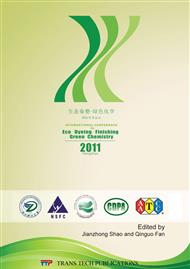[1]
T. Sato, N. Oku, E. Iida, K. Kawaguchi, K. Yamanaka, T. Mori, S. Okada, Differential effect of UV-B and UV-C on DNA damage in L-132 cells, Biol. Pharm. Bull. 19 (1996) 721-725.
DOI: 10.1248/bpb.19.721
Google Scholar
[2]
N. Dumaz, H.J. van Kranen, A. de Vries, R.J. Berg, P. W Wester, C.F. van Kreijl, A. Sarasin, L. Daya-Grosjean, F.R. de Gruijl, Theo role of UV-B light in skin carcinogenesis through the analysis of p.53 mutations in squamous cell carcinomas of hairless mice, Carcinogenesis. 18 (1997).
DOI: 10.1093/carcin/18.5.897
Google Scholar
[3]
B.K. Armstrong, A. Kricker, The epidemiology of UV induced skin cancer, J. Photochem. Photobiol. B. 63 (2001) 8-18.
Google Scholar
[4]
R.T. Greenlee, T. Murray, S. Bolden, P.A. Wingo, Cancer statistics, 2000, CA Cancer J. Clin. 50 (2000) 7-33.
DOI: 10.3322/canjclin.50.1.7
Google Scholar
[5]
D. Cristea, G. Vilarem, Improving light fastness of natural dyes on cotton yarn, Dyes Pigm. 70 (2006) 238-245.
DOI: 10.1016/j.dyepig.2005.03.006
Google Scholar
[6]
A.F. Strobel, Improvement of lightfastness of dyeings on synthetic fibers by ultraviolet absorbers, part II, Am. Dyest. Reptr. 51 (1962) 35-40.
Google Scholar
[7]
W. Czajkowski, J. Paluszkiewicz, R. Stolarski, M. Kaz´mierska, E. Grzesiak, Synthesis of reactive UV absorbers, derivatives of monochlorotriazine, for improvement in protecting properties of cellulose fabrics, Dyes Pigm. 71 (2006) 224-230.
DOI: 10.1016/j.dyepig.2005.07.004
Google Scholar
[8]
J. -P. Bacher, W. Kaufmann, D. Reinehr, Triazine ultraviolet absorbers useful for improving the sun protection factor of textiles, U.S. Patent 5, 741, 905. (1998).
Google Scholar
[9]
Y. Sun, G. Gong, X. Sheng, D. Zhao, Research on synthesis of 2-hydroxy-4-methoxy-3'-amino-di-benzophenone and its alkyl derivatives, J. Dalian Univ. Technol. 46 (2006) 792-796.
Google Scholar
[10]
J. Xiao, S. Zhang, J. Yang, Q. Huang, Study on chemical bonding of polycarboxylic acid black on cotton and its dyeing and finishing properties, Dyes Pigm. 73 (2007) 111-117.
DOI: 10.1016/j.dyepig.2005.10.018
Google Scholar
[11]
L. He, G. Gong, H.S. Freeman, W. Jian, M. Chen, D. Zhao, Studies involving reactive dyes containing a benzophenone ultraviolet absorber, Color. Technol. 127 (2011) 47-54.
DOI: 10.1111/j.1478-4408.2010.00277.x
Google Scholar


